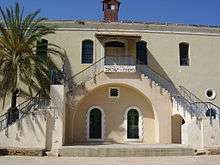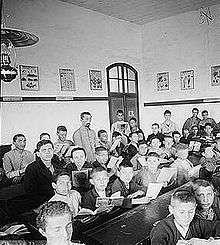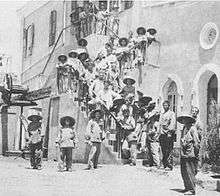Mikveh Israel
Mikve Israel, or Mikveh Israel, or מקוה ישראל or מקווה ישראל

Mikveh Israel (Hebrew: מִקְוֵה יִשְׂרָאֵל; "Hope of Israel") is the first Jewish agricultural school in Israel.[1]
History

Charles Netter established the school in 1870 on a tract of land southeast of Jaffa leased from the Turkish Sultan, who allocated 750 acres (3.0 km2) to his project.[2] Netter, the first headmaster, introduced new methods of agricultural training. Baron Edmond James de Rothschild contributed to the upkeep of the school.
The name is taken from two passages in the Book of Jeremiah - Jeremiah 14:8 and 17:13. It was proposed by Wolf Grinstein, one of the school's first students, who later taught there.
In 1898, Theodor Herzl met the German Emperor Wilhelm II at the main entrance of Mikveh Israel during Herzl's sole visit to Palestine. The meeting, a P.R. event engineered by Herzl to publicly meet the Kaiser, was misinterpreted by the world media as a legitimization of Herzl and Zionism by Germany.

[3][4] Today, entrance to the school grounds is via the city of Holon.[2]
The village and Agricultural School “Mikve Israel” were founded in April 1870 by Charles Netter, an emissary of the French organization Alliance Israélite Universelle (in Hebrew “Kol Israel Chaverim”), aiming to be an educational institution where young Jews could learn agriculture and leave to establish villages and settlements all over the country and to make the desert blossom. The Alliance Israélite Universelle is a Paris-based international Jewish organization founded in 1860 by the French statesman Adolphe Crémieux, who believed in universal emancipation by French culture, to safeguard the human rights of Jews around the world. The organization promotes the ideals of egalitarianism, solidarity, social equity, calling the Jews to bear responsibility for one another, promoting empowerment and self-sufficiency through education and professional development. Netter pioneered progressive educational methods and a new way of life and agricultural training to the future farmers of this land. There were only about 20,000 Jews in the country at that time, virtually all established in the old traditional cities of Judaism: Jerusalem, Tiberias, Safed and Hebron. The country’s Ottoman Turkish rulers then allocated 750 acres (300 ha) to Netter’s project. Baron Edmond James de Rothschild contributed to the upkeep of the school. The Mikve Israel School was actually established as a youth village, which included all the required elements of an agricultural village: water wells, public buildings, homes for the children and the laborers and other facilities for agricultural classes, a defense system, village institutions and more.
Pedagogy
Since its creation, the school has not stopped functioning not even for one day, and tens of thousands of Jews and non-Jews have acquired a general education and professional training. For many decades (until the establishment of the Volcani Center and the Faculty of Agriculture in Rechovot) the school served as the research center for the country. Their teachers wrote the first study books about agriculture and served as field advisors. Most of the agricultural know-how of the first 50 years was collected and published by Mikve Israel. From its inception, Mikve Israel was an institution which absorbed immigration. Youngsters who escaped anti- Semitism and pogroms in Eastern Europe counted among its first pupils, side by side with refugees from Asia Minor and elsewhere. Together with the children of Israel they were the boarding school’s population, serving as a melting and absorbing multicultural system, educating youth from many different origins. After finishing their studies, the thousands of graduates left Mikve Israel to start agricultural settlements of all kinds, villages and kibbutzim, moshavim, farms and agricultural schools; or serving in management positions; or continued their agricultural studies in institutions of higher learning and filling positions in research and development, the export branches, marketing and agricultural management. In 1938/39, at the request of the Aliyat Hanoar – Youth Alya Department -, a section for religious youth was built next to the general section which was in use since the beginning, to house the religious and traditional youngsters who ran away from Western Europe just before the start of the Holocaust. The two sections - general and religious - have since functioned in harmony for more than 75 years, with mutual respect for the Jewish values, tolerance, concern and represent a model of interreligious cooperation for the Israeli education system. Over all the years, Mikve Israel has not only educated tens of thousands of children, the school has developed a tradition of volunteerism, public service and the use of the internal resources for the needs of the country. From an institution that saw its objective as bringing back the glory of old-time agriculture and empowering the new settlement on the way to food self-sufficiency. “Teach a man to fish and you feed him for life.” Through the training of specialists and settling them on the soil, educating generations of professional farmers who have sprayed their knowledge, training to defend the country, absorbing new immigrant youth from all the corners of the earth, giving them a warm home and providing a refuge from persecution at all times, creating a building atmosphere, and until the establishment of a modern and advanced teaching system, with the focus on agricultural education with general and technological know-how, the school has not rested on its laurels. It is always looking for ways to provide an answer to its educational needs and to the schooling challenges of a new generation, without leaving behind the values it nurtured and without which there is no excuse for being in this land.

Geography
Mikve Israel is located on a strategic cross point, on the main national axis, on the road connecting Tel-Aviv to Jerusalem, the economy to the politics, the secular to the religious. It connects Tel-Aviv sea shore in the east to the western part of the country and stands at the intersection with the road leading to the south and the Negev desert. Today, Mikve Israel makes an essential contribution to the “green lung” that helps preserve open space around densely populated Tel Aviv and the towns of the surrounding Dan Region. It has paid its share in the defense and the security of the country, defending itself during the pre-State period, becoming a border village and a guarding post and was an organizing point for the convoys and up to the Gulf War - Operation Sand Storm. As an institution placed at the center of the Dan Region, and surrounded today by sprawling suburbs, the school preserves the only greenery in the heart of a metropolis and is proud of its care of the gardens, tree groves and historical sites, which attract thousands of visitors, becoming a magnet for the learning of the history of the settlements and leisure. Together with the Society for the Preservation of Historical Sites and Buildings, many historical buildings were lately restored, which represent the pride of the new Jewish settlement, but there is still a lot of work to be done. The agricultural grounds of Mikve Israel cover over 2,200 dunams (out of a general area of 3,300 dunams). Most of the fields are irrigated and include all the vegetable kingdom - field crops, industrial crops, vegetables, fruit trees, orange groves and greenhouses; the raising of animals - milk cows, chickens and honey bees; and auxiliary branches - computerized agriculture, and several services.
Present day Mikve Israel, the School system
The village is currently run by Ronen Tzafrir, Director General and a board headed by Ilan Cohen, chairman. 1,500 pupils learn all over the year on the campus. The Junior High School is thought of as excellent in its region and emphasizes subjects related to the environment and protection of the natural resources of the country, on a background of what is done in the school and in the agricultural scene as a whole. In 2007, Mikve Israel and the Alliance Israélite Universelle, inaugurated together with the Israeli and French Education Ministries an experimental bilateral Israel-France high school - unique in the world - leading half of its pupils to the French Baccalauréat and half to the Israeli Bagrut. To-date, in less than 8 years of existence, the pilot project has grown to a 380 pupil’s international school mixing together youngsters from the age of 12 to 18 from all French speaking countries and from Israel. Today there are about 1,500 pupils from the age of 12 to the age of 18. 800 hundred in the General section, 320 in the religious school, 380 in the French-Israeli college and high school. The dormitories have a fully utilized capacity of 280 beds split in religious and secular boarding schools. Israel hosts 3 Montessori kinder gardens, and 1 Montessori elementary school in the making. In addition, a special program prepares 35 future professional soccer players every year. Mikve Israel collaborates with various ministries amongst them the Ministry of Education and the Ministry of immigrant absorption. All these populations live together on the same campus, sharing facilities such as the numerous outdoor and indoor sports grounds, the open air and covered amphitheaters, the cafeteria, the huge dining hall shared by students and teachers, the specialized libraries, the science laboratories, etc…
General Data
- Total area: Mikve Israel extends over an area of 3,300 dunam (330 ha)
- Cultivated area: 2,500 dunam (250 ha)
- Independent geographic authority: Mikve Israel has a special autonomous status, as recognized by “Law Mikve Israel”.
Physical resources
Water quota: 498,000 cubic liters, produced on its own from 4 wells 2,200 dunam (220 ha) of field crops.
Main crops:
- Wheat for seeds and hay
- Vetch crops (vicia), for animal feed
- Watermelon for seeds
- Chickpeas
- Orchards
- 200 dunam (20 ha) of avocado orchards
- 10 dunam (1 ha) Shamouti orange orchard
- 5 dunam (1/2 ha) wine vineyard
The avocado orchards at Mikve Israel are cultivated in partnership with Pri Or Mehadrin Ltd. and are the first to reach the market in season.
Dairy Farm
- Milk quota: 918,000 liters
- 150 head, of which 76 are dairy cows
The Mikve Israel dairy farm embraces technologies such as genetics, computers, milking parlor and cooling, product quality control, feeding, herd health, udder health, artificial insemination and embryo transfer and implants.
Chicken coop
- Egg layers: 4,400 hens
- Mikve coop egg quota: 1,137,000 eggs
Poultry activity
- Four cycles of 12,000 chicks
- Average of 96 tons of meat
Greenhouse One dunam (0.1 ha) The aim of the greenhouse production branch is to teach students and allow them to research greenhouse issues and technologies. A rain harvest system allows efficient re-use of water collected from the roof for growing of vegetables in greenhouses:
- Tomatoes
- Peppers
- Eggplant
- Broccoli
- Garden plant rooting
Gardening and landscaping 100 dunam (10 ha) The gardening and landscaping activity includes woods, lawns and beauty & leisure gardens and spots throughout the village. The gardening and landscaping is maintained by the students supervised and coached by the manager of this production branch.
A Botanical garden for biodiversity conservation 70 dunam (7 ha) At its origin the botanical garden was established in 1930, in order to adapt and acclimate trees and species to the local climate. Plants were imported from all over the world. In 2008, the Ministry of Agriculture & Rural Development recognized the Mikve Israel botanical garden for its unique heritage and biodiversity value, the prime aim of which is to serve as a place of learning for students at the agricultural school as well as for students and youth from the surrounding areas.
Stables Horseback riding school The stable has the following breeds of riding horses: Hanoverian, Holland and quarter breeds suited to all types of horseback riding: western, sports, and therapeutic riding.
See also
References
| Wikimedia Commons has media related to Mikveh Israel. |
- ↑ Mikve Israel Encyclopedia of Zionism and Israel, edited by Raphael Patai, New York, 1971
- 1 2 http://www.goisrael.com/Tourism_Eng/Articles/Sites/Mikve+Israel+Agricultural+School.htm
- ↑ http://www.shimur.org/english/article.php?id=13
- ↑ EMAIL, Jewish Magazine. "Theodore Herzl and Rev. William Hechler and the Zionist Beginnings". jewishmag.com.
Bibliography
Coordinates: 32°02′N 34°47′E / 32.033°N 34.783°E